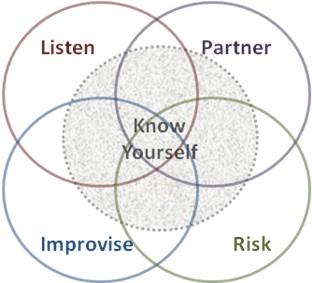To Link or Not To Link
 A colleague recently asked me how I handle LinkedIn invitations from people I don’t really know. Another colleague asked about connecting to people whose reputation is questionable. While the same questions can be asked about Facebook, Google Plus and other social media, because of the differences in the types of services and benefits each offer, I’m only going to discuss LinkedIn here, and address mostly issues relating to trust.
A colleague recently asked me how I handle LinkedIn invitations from people I don’t really know. Another colleague asked about connecting to people whose reputation is questionable. While the same questions can be asked about Facebook, Google Plus and other social media, because of the differences in the types of services and benefits each offer, I’m only going to discuss LinkedIn here, and address mostly issues relating to trust.
Trust All Connection Requests?
When people ask me questions about whether to accept invitations, they are usually not asking about the business benefits of making the connection. Often, they are asking about the business and personal risks associated with accepting the invitations.
Recently, Charlie Green shared a Trust Tip via Twitter (#57 Trust but verify? No. Trusting means you don’t need verification). He explained the Tip more in his Trust Tip Countdown blog. While trusting without verifying may be appropriate in some circumstances, it is not appropriate for everything. In his presentations, Charlie often says “I trust my dog Sammy with my life, but not with my ham sandwich.” It is common sense to not leave a sandwich in front of a dog, if you expect it to be there a minute later. Accepting an invitation from someone we don’t know, poses some risks, and requires some verification in advance.
Here are some risk scenarios that may result from accepting LinkedIn invitations:
- I don’t block my connections from seeing who my other connections are. Some people do block that access on LinkedIn. Sharing LinkedIn connection names has the risk that some of your connections will contact people with whom you are connected without your permission, by using your name. I’m told that because of this risk, recruiters block access to their connections.
- If we connect to a person who has a reputation of not being trustworthy, that could reflect badly on us.
- Some people are concerned about connecting with competitors. That might increase your opportunity to collaborate and generally benefit from being connected. You may also be concerned about whether your competitor will misuse your contact list, or take business advantage of other aspects of being connected.
- If you don’t know many of your connections well enough to introduce others to them when requested, having a lot of connections may seem disingenuous. Of course, there may be business or other reasons we choose not to accommodate an introduction request. One of these reasons should not be: “I really don’t know that person.”
Best Practices Suggestions for Accepting Invitations
Here are three typical scenarios I encounter when I receive an invitation on LinkedIn. I quickly assess the risk, and simultaneously look for ways to increase the business benefits of the potential connection. :
1. I already know the person or we have at least met in person or by phone or online.
I think about how well I know the person, and assess whether I will be comfortable with connecting the individual to other people I know. I have fairly liberal standards, and generally opt in favor of connecting. I may have met the person briefly at a conference or we may be in a virtual group together. Before accepting the invitation, I may reach out to the contact and ask for a phone call so that I can increase my comfort level and trust.
2. I don’t know (or remember) the person, but we have connections in common.
For these potential connections, I investigate further, by reviewing their profiles on LinkedIn, and using Google to check their online presence. Generally, I am likely to connect based on my investigation, relying in part on the transferred trust from the person I know. Sometimes I even write to our common connection and ask if s/he knows the person. In addition, before I connect, I am much more likely to reach out and ask the person to have a phone call with me so we can establish or enhance our relationship.
If the person seeking to connect with me on LinkedIn does not want to have a call with me, that is a sign that I should not accept the invitation. Having the conversation creates a stronger connection, and could give me more information as to whether it makes sense to connect. Interestingly, I recently received an invitation without a personal note reminding me of where I met the person. It turns out she was a student in a class I taught on coaching. I emailed to ask her if we knew each other, and we then had a follow up call. We are now building a relationship, and I would not hesitate to introduce her to my other LinkedIn connections.
3. I don’t know the person, and we have no connections in common.
I suspect some of these requests are spam, but just in case, I usually investigate further by reviewing the person’s profile, and researching them on Google. Recently, I’ve been receiving invitations from people who have high ranking titles, and appear to be part of solid companies, usually from outside the US. Yet, they have only a very few other connections. Their invitations do not indicate how they know me, or why they want to connect with me. I ignore these.
Those invitations that do not appear to be spam often look like they are from people who are using LinkedIn’s service to connect to everyone in a group, or everyone in their email database, regardless of whether we know each other. I think about each one, and determine whether I want to reach out and have a call or connect by email or just ignore it. I just use common sense. You may end up with a good connection, or you may just be clogging your LinkedIn with people who you cannot help or from whom you can ask for help.
Make Invitation Requests Easier to Accept
I enjoy getting invitations and inviting people to connections. My advice – when inviting someone to connect on LinkedIn, don’t just use LinkedIn’s template. Personalize it, and, unless there is no question that the person knows you, remind her/him how you met, and why you want to connect. Make it easy for both of you.

 A competency model won’t answer the mail when it comes to building trustworthiness—in fact,
A competency model won’t answer the mail when it comes to building trustworthiness—in fact,  I recently ran for a seat on the condo board of the brand new community I live in. I lost. In front of about 60 people.
I recently ran for a seat on the condo board of the brand new community I live in. I lost. In front of about 60 people.